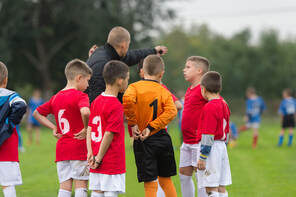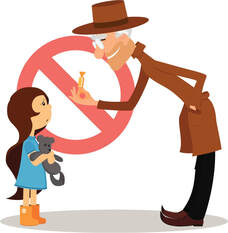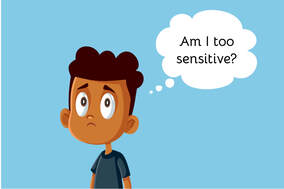"The majority of offenders do not look, act, or speak in any way that would identify them as sex abusers. They rarely wear trench coats or masks. They’re hard to spot, they look like you and me."
- Darkness to Light, Trust your Gut" - https://www.d2l.org/trustyourgut/
|
What is Grooming?
Negative grooming is defined as the slow and meticulous process of building trust and comfort with a child (and often, his/her family) by an adult or person in a position of power, as a means to be able to gain access to the child to abuse him/her. Negative grooming usually starts with behaviours that don't look inappropriate and that even could be seen as the adult being very good with children. Abusers target children that are vulnerable and start filling their needs - affective, economic, role model, etc. Groomers are people are most often people close to the child and his/her family. |
How could you recognize the Grooming process?
The answer is quite simple: when an adult starts to spend time alone with a child. It doesn't matter is the adult is a family member, a coach, a family's friend; the offender uses the special relationship with the child to create situations in which they end up alone together. Tutoring, coaching and special trips all enable emotional isolation. The offender creates a belief that they can provide something that no one else, not even a parent, can. https://metoomvmt.org/learn-more/glossary/ |
Why is it hard to stop it?
Because the offender has worked for a long time to be trusted by the kid and the adults around him/her. At some point the child may realize what is happening but still not want the relationship to end out of fear or because they feel a sense of duty to the groomer. At the same time, the parents or adults around "would never believe" that the offender is actually a bad person, so even if the child says something, the chances that he/she will be believed will be low, which makes the child even more afraid to say something. |
How does it start?
The Negative Grooming process looks like a normal behavior when it starts; the initial stages are full of attention, light conversations and care. The offender uses this to gain the child’s (and their caregiver's) trust and then uses this "trust" to gain access to the child and abuse him/her.
The implementation and development of negative grooming tactics can take place over days, months and even years. It can be difficult to tell if a child is being negatively groomed – the signs are not always obvious and may be hidden.
It is important to remember that children and young people may not understand they are being groomed. They may have complicated feelings such as loyalty, admiration, love, as well as fear, distress, and confusion. The other adults and caregivers are also often unaware that they themselves are being negatively groomed.
The implementation and development of negative grooming tactics can take place over days, months and even years. It can be difficult to tell if a child is being negatively groomed – the signs are not always obvious and may be hidden.
It is important to remember that children and young people may not understand they are being groomed. They may have complicated feelings such as loyalty, admiration, love, as well as fear, distress, and confusion. The other adults and caregivers are also often unaware that they themselves are being negatively groomed.
The Myth of Stranger dangerIt’s short. It’s simple. But is it really the most effective way to prevent abuse?
- "Victims know their offender 90% of the times. Abuse comes from people we know and trust." - https://www.d2l.org/wpcontent/uploads/2017/01/all_statistics_20150619.pdf? Avoiding strangers will not help if the perpetrator is a family member, neighbor, teacher or coach. When you talk to your children about abuse prevention, don’t focus on warning them about certain types of people. Instead, teach them to identify and respond to threatening situations. If you want to read more tips about it, click here: https://www.kidsmartz.org/StrangerDanger |
|
- An adult targeting specific kids for special attention, activities, or gifts. Some offenders show preference for a particular gender, age, or “type.” Grooming starts with friendship to gain the trust of the kid and their caregiver. - An adult spending a lot of time with a single child is a red flag. The Rule of Three is important. Always try to have at least two adults and one child present or one adult and two children present. Slowly isolating a kid from family members and friends: physically and emotionally. This could include finding reasons for isolated, one-on-one interactions (sleepovers, camping trips, day activities, etc.), or undermining relationships with parents and friends to show that “no one understands you like I do.” - Gradually crossing physical boundaries. - Gift giving to the child and/or the child's family. - Encouraging a kid to keep secrets from family members. The shame and fear associated with child sexual abuse makes it easy for offenders to enforce secrecy in this area as well, keeping abuse “just between us.” https://www.d2l.org/child-grooming-signs-behavior-awareness/ |
Secrets
"Most perpetrators will tell the child to keep the abuse a secret. This can be done in a friendly way, such as, “I love playing with you, but if you tell anyone else what we played they won’t let me come over again.” Or it can be a threat: “This is our secret. If you tell anyone I will tell them it was your idea and you will get in big trouble!” Tell your kids that no matter what anyone tells them, body secrets are not okay and they should always tell you if someone tries to make them keep a body secret." - https://childmind.org/article/10-ways-to-teach-your-child-the-skills-to-prevent-sexual-abuse/
Stages of the Grooming process"-Targeting a vulnerable victim
-Gaining the child and family's trust -Filling the needs -Breaking the rules -Isolating the child -Sexualizing the relationship -Confusing the child as if he/she is equally responsible -Creates emotional dependency" Respect Group, Six stages of Grooming https://www.d2l.org/child-grooming-signs-behavior-awareness/ |
|
So what do you do if you detect one of these behaviors?
Eliminate or reduce the isolated one-on-one situations between kids and adults.
What is a one-on-one situation? It’s a meeting between two people when no one else is around.
- "More than 80% of sexual abuse incidents happen in isolated one-on-one situations"
- https://www.d2l.org/education/5-steps/step-2/
- https://www.d2l.org/education/5-steps/step-2/
Examples of risky one-on-one situations: a sports coach driving a kid home after a game, an uncle reading a bedtime story with the room door closed, a teacher who asks a student to stay after school for a private consultation, a babysitter changing the kid’s clothes with the door closed, an older cousin and a kid playing in the basement.
"It’s important to be an active bystander and intervene when we see grooming tactics and boundary violations. By intervening you are letting the adult who crossed the boundary know you are vigilant. When you intervene describe the inappropriate behavior to the adult who crosses it, set a limit on the person who has crossed the boundary, and move on by refraining from making a dramatic scene. Just state the limit in a calm, direct manner. When intervening, it’s not important that you know the intentions of the person who has crossed the boundary. What is important is that you reinforce the boundary and that the person who violated the boundary is willing to follow the limit you set. It’s also okay if your intervention happens in front of others. If there is a pattern of boundary violations, or if you've intervened and boundary violations continue, you now have a reasonable suspicion and you should make a report."*
*https://www.d2l.org/trustyourgut/
"It’s important to be an active bystander and intervene when we see grooming tactics and boundary violations. By intervening you are letting the adult who crossed the boundary know you are vigilant. When you intervene describe the inappropriate behavior to the adult who crosses it, set a limit on the person who has crossed the boundary, and move on by refraining from making a dramatic scene. Just state the limit in a calm, direct manner. When intervening, it’s not important that you know the intentions of the person who has crossed the boundary. What is important is that you reinforce the boundary and that the person who violated the boundary is willing to follow the limit you set. It’s also okay if your intervention happens in front of others. If there is a pattern of boundary violations, or if you've intervened and boundary violations continue, you now have a reasonable suspicion and you should make a report."*
*https://www.d2l.org/trustyourgut/
|
Now you know that you are an important factor to prevent and stop abuse; you learned how to be an active bystander and how to recognize is someone is being groomed.
Click HERE to take a quick test to confirm everything you've learned. |
Online Grooming
Children often meet people through social media or online gaming. The problem is that very often this people are not who they say they are, so it is very important to talk with them about the risks of online interactions.
Online ThreatsGroomers are not always strangers and sometimes children may not be aware that they are being groomed. Instead they believe they are developing a safe interaction with the person.
"On social media, online groomers will often target a number of young people at any one time by sending out friend requests to see who responds. Through online forums and online games, they may strike up a conversation to build a relationship with a child and ask them to continue the talking on another platform or chat privately." - Learn about online grooming to support children | Internet Matters |
Some statistics"Almost one in five young people who shared nudes were either blackmailed, bullied or harassed to send more photos."
Source: Cybersurvey- In Their Own Words – The Digital Lives of Schoolchildren - 30% of 12-15-year-olds said they had been contacted by a stranger online who wanted to be their friend. Source: Ofcom – Children and parents media use and attitudes report 2020-21 " 2 in 5 young people had never told anyone about the worst thing that had happened to them online." Source :Hopes & Streams - London Grid for Learning (lgfl.net) |
Protect Children- Show them where to get help if they are concerned and to talk to you or a trusted adult for support.
- Spend time discussing where they interact with friends online and how and what information they share with others. - Explain how easy is to pretend to be someone else online and why an adult may wish to approach them. - Never share private details which could identify them like name, school, address, etc. |
How to know if your child is being groomed?
"There are a number of signs to be aware of (although a lot of them are quite common among teens), but look out for increased instances of:
"There are a number of signs to be aware of (although a lot of them are quite common among teens), but look out for increased instances of:
- wanting to spend more and more time on the internet
- being secretive about who they are talking to online and what sites they visit
- switching screens when you come near the computer
- possessing items – electronic devices or phones – you haven’t given them
- using sexual language you wouldn’t expect them to know
- becoming emotionally volatile"
What is Gaslighting?
Gaslighting is a type of emotional abuse where the bully or abuser misleads and confuses the victim, creating a false narrative and making the victim question his/her own judgment. The victim of gaslighting starts to feel unsure about how things happened, to the point where they will believe whatever their abusers tell them, instead of the actual facts. This often leads the victim of gaslighting to question their sanity. Gaslighting starts small, with seemingly innocent but distorted information that slowly confuses the sense of reality of the victim.
When we hear the word 'abuse', we immediately think of a person being violent and another person resisting or feeling helpless; in reality, most victims are not aware that they are victims until it is too late, this is especially true for children.
Abuse takes time, it slowly builds up. Often, the abuser first studies the situation and starts the grooming process were he/she gains the trust of the victim and their support network.
The grooming process, at first looks like normal behavior such as attention, light conversations and care. At this point the red flag is the underlying motivation behind the behavior and not the overt actions and this is why in the early stages in can be difficult to catch.
The implementation of grooming tactics can take days, months and even years. One of the many tactics is 'Gaslighting'. Its goal is to slowly confuse the sense of reality of the victim and their support network through phycological manipulation. Victims end up second-guessing everything: how they feel, what they think, who to trust. When the victim loses clarity and confidence, the abuse gets to the next level: physical/sexual.
Learning how to identify red flags, helps us identify and stop abuse before it happens, or in the early stages. We must remember it is never to late to intervene.
We don’t have to live in fear, we just need to keep our eyes open.
When we hear the word 'abuse', we immediately think of a person being violent and another person resisting or feeling helpless; in reality, most victims are not aware that they are victims until it is too late, this is especially true for children.
Abuse takes time, it slowly builds up. Often, the abuser first studies the situation and starts the grooming process were he/she gains the trust of the victim and their support network.
The grooming process, at first looks like normal behavior such as attention, light conversations and care. At this point the red flag is the underlying motivation behind the behavior and not the overt actions and this is why in the early stages in can be difficult to catch.
The implementation of grooming tactics can take days, months and even years. One of the many tactics is 'Gaslighting'. Its goal is to slowly confuse the sense of reality of the victim and their support network through phycological manipulation. Victims end up second-guessing everything: how they feel, what they think, who to trust. When the victim loses clarity and confidence, the abuse gets to the next level: physical/sexual.
Learning how to identify red flags, helps us identify and stop abuse before it happens, or in the early stages. We must remember it is never to late to intervene.
We don’t have to live in fear, we just need to keep our eyes open.
|
Gaslighting can include a range of tactics such as lying, distracting, minimizing, denying, and blaming.
Gaslighting language: "I never said that" "You always exaggerate" "You must have imagined that "That never happened" "You’re too sensitive" "It’s not a big deal" "Don’t take things so personally" "I was just kidding" |
Clarity helps to set boundaries and communicate expectations efficiently. Some steps you can take to protect yourself and others:
Take some distance Save the evidence Take notes (so you remember). The more precise, the better, such as dates, times, etc. Set boundaries Get an outside perspective End the relationship. |
This is a movie about the grooming process: "An Open Secret": vimeo.com/142444429
Here we share some articles we recommend for you to read:
|
Commit to Kids – Guide for Parents Brochure (online PDF, free)
https://www.protectchildren.ca/en/order/product/229:en/ |
Darkness to Light - Grooming and red flag behaviours
https://www.d2l.org/child-grooming-signs-behavior-awareness/ |
Short video that describes the grooming process with a family member:
. https://youtu.be/-fUrmvalK38 |












